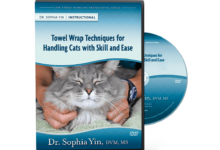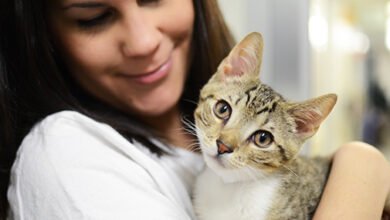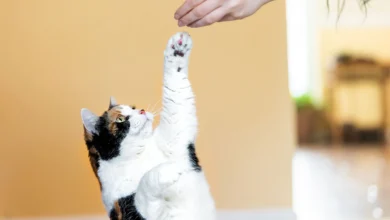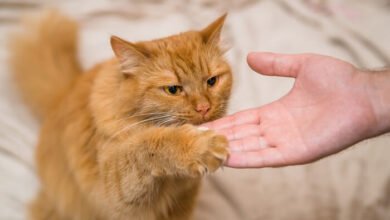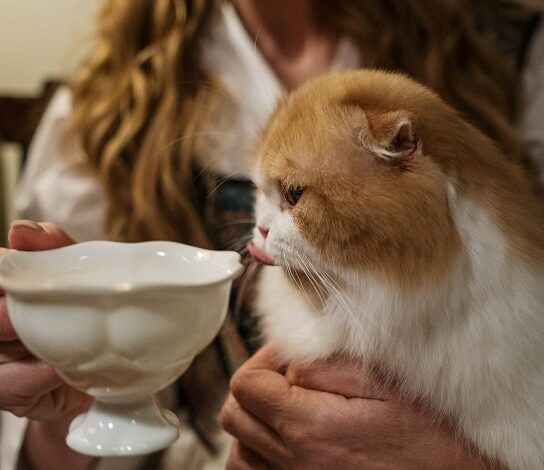
How to Wean a Bottle Fed Kitten
A common problem with new kitten owners is knowing when to start the weaning process,
First off, a kitten needs milk during the first four to five weeks of age so it’s usually not a good idea to start before week four.
It is important to be patient! Remember, your kitten is still a baby and has a very delicate stomach. Also, always use high quality cat food during this important stage of your kitten’s life.
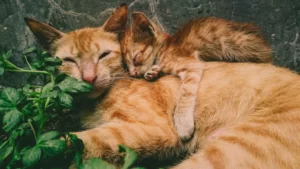
Week four is the average time to start weaning but some kittens might take longer so looking for some signs will help you in knowing when to wean a kitten.
They will generally signal an interest in solid foods by biting the bottle nipple or showing an interest in licking milk or formula from a finger.
To start weaning, try feeding some formula or milk from a spoon or in a small bowl or flat dish.
The next step is to begin adding some high quality canned kitten food with the milk (or water) and making a soft paste out of it.
Don’t use a dry food yet unless it is thoroughly moistened as a kitten can’t chew dry food until they are 8 weeks old. It is a good idea though to make some dry food available as some kittens like to crunch on the smaller pieces.

Use a bowl that is easy to access and putting a little of the food on the kitten’s mouth might help stimulate their appetite as they will have a natural tendency to look it off. Avoid blocking the nose with food or formula so your kitten can breathe easily and not panic.
You should continue to bottle feed during this process to make sure the kitten is getting enough to eat and slowly reduce the feedings as the kitten eats more solid food.
Around the eight week mark you can start to make the transition to dry food if you wish by slowly introducing dry food with the canned and reducing the amount of canned food you use until you only use dry.
Weight gain can be slow and some diarrhea is common but if it is excessive it can be a serious life-threatening problem and you should take the kitten to your vet immediately.
Continual weight gain is the goal and a good rule of thumb is around four ounces a week.
Should You Train Your Kitten to Use a Litter Box?
The short answer to this is YES! Even if you are going to allow your cat to be outdoors whenever it wants, you need to be sure that if ever there was a time when it couldn’t get outside for whatever reason,
it’s already potty trained and can use the litter tray whenever necessary. It may not be happy using the litter tray but you probably don’t care about that should you find yourself in a situation where allowing your kitten outside isn’t an option.
It could be that you need to be out of town for a few days and you don’t want to leave your cat door unlocked for security reasons, so your kitten needs to kept indoors.
It could be that it’s too cold, especially at night in the winter, so you want to keep him inside so he doesn’t come to harm in sub-zero temperatures.
It’s even more possible that at some time in his life, he will need a surgical procedure that will result in him being kept indoors for at least 24 hours.
If you have trained your kitten to use a little box, the cat he grows into won’t have a problem if he finds himself locked inside with no means of getting out.
When you first bring your kitten home, have a litter box ready for him to use. You won’t be letting him out for those first days when he’s tiny, so use this time to “potty train” him.
Use a shallow tray that he can easily get into and put a layer of kitty litter into it. As he grows, always have a clean litter tray available,
even if he doesn’t use it he’ll learn where it is and when the day comes that he finds himself lock inside, he’ll know where the “bathroom” is and how to use it.
How to Take Care of Your Cat
Cats are cute creatures that can take care of themselves. But if you were to have one as a pet, you should know certain things about how to take care of your cat. It is different when you got this as a kitten to a full grown feline.
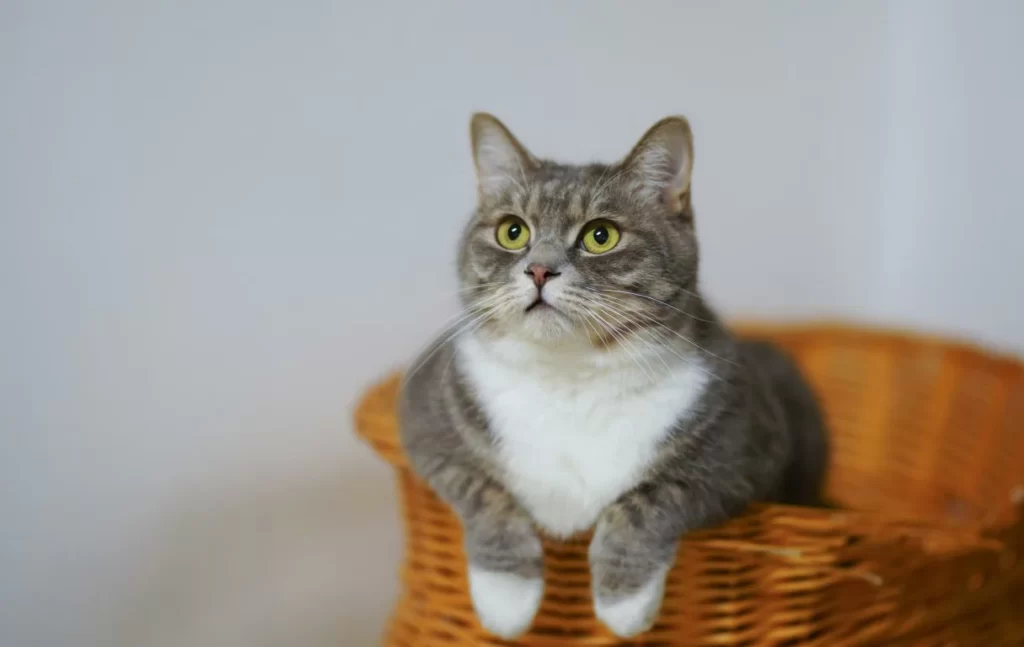
If you got this as a kitten, it will easily be able to adapt itself to the environment because it will allow itself to be ruled by other pets. This means there will be fewer incidents of fighting among themselves.
Lucky for you, kittens that often sold to owners are already litter trained. The only thing you have to do now is teach it where to go when nature calls.
Your kitten will follow you wherever you go and at times jump or climb up to the kitchen counter or table. This isn’t good if you have food there so discourage this habit by having a bottle full of water around so you can squirt it into their face.
It will also be a good idea to install a scratching post since this is their way of sharpening their nails. If they do this elsewhere, spray them again in the face.
Apart from working on the scratch pad, you should trim their nails before it gets too sharp that it could hurt someone or damage the furniture in the house. You do this by pressing down on each toe which makes the claws extend. This should be inspected regularly so they also get used to it as they grow older.
Kittens do not shed that much hair compared to bigger cats. But you should comb them anyway so they get used to it regardless if your pet is a short or long haired cat.
Don’t just give your cat anything to eat. They must be of good quality that can be found in the pet store. If you are not sure about which brand has the highest vitamins and minerals, go ask your vet for some recommendations. There must be a clean bowl of water as well so they don’t get dehydrated.
Aside from feeding the kitten, he or she should be brought to the vet for shots. They usually get a few while they are young but get a regular one annually as they get bigger. Be sure to keep a record of the shots so this can be shown to the doctor.
If you have a big cat, give them room to adapt to the new environment on their own. If your pets quarrel, don’t worry or get in between them because this is normal. But if things are really bad, then you have to separate them by confining both in different rooms.
An older cat also needs to be disciplined so they know what they can and cannot do. This is why you need to keep the squirt bottle handy as this is the best way to tell them it is wrong without physically hurting them.
House cats should always be kept indoors. Studies have shown that this extends their life for over ten years since going outside puts them at risk of being hit by a car or contaminated with a virus from stray animals. Just so you know strays cats that live outdoors only live for a couple of years.
It doesn’t take much to know how to take care of a cat. Do some research and practice so both of you will enjoy each other’s company.
Falling in Unrequited Love with a Siamese Mix
Twelve years ago, after he started living on his own, my son adopted a Siamese mix and called him, “Yoda.”
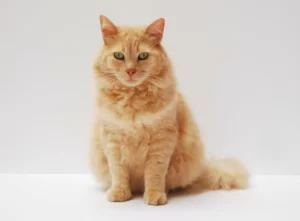
Although a mix, Yoda has the temperament, large ears, huge blue eyes, and the cute, dark face of a true Siamese.
He has also acquired their thermosensitivity of the Siamese’s coat coloring. The only part of Yoda that would alert a knowing eye that his iffy bloodline is the slightly rounded shape of his face, as the pure-bred Siamese are known to have elongated faces.
Yoda only takes to my son, nobody else. He has gotten used to my daughter-in-law, and just that, because no one can replace his true owner.
Although I have taken care of Yoda numerous times and he stays with me every now and then, he barely tolerates me, and that is when he needs fed or asks for a treat.
Knowing the Siamese psychology, I don’t blame myself or my cat-sitting skills, but I sort of wish he’d jump on my lap and purr like the tabbies I once owned.
Maybe it is the Himalayan gene that the Siamese share with rabbits and mice that makes Yoda hop away from me after his needs are met. This could be also because Yoda’s gene memory prevents him from getting on with too many people at a time.
In their country of origin, Siam (now called Thailand), the Siamese cats guarded the Buddhist temples and were considered sacred.
Their blood lines were vigilantly protected; and the cats were bred as if they were angels sent from heaven. Later on, the Siamese became the cats of royalty, babysitting for the King’s children.
Inside the “Cat-Book Poems,” a manuscript written in Siam during 1350’s, seal-point Siamese looking like Yoda are pictured.
Those cats in those old pictures must be the representations of adult Siamese cats, because a Siamese kitten is pure white at birth. Since the Siamese kitten‘s coat is heat-sensitive, in time, it develops the point color: that is, the points on his tail, paws, and face.
At his advanced age, Yoda’s coat still changes color according to heat. When he stays with us, Yoda demands to be let out to the porch.
From behind the screen and the glass doors, this cat loves to watch the golf course, the squirrels, the birds, and the golfers goofing up their swings.
When Yoda stays in our house, because he goes on the porch so often, his coat lightens up, giving him a younger look.
For an aged cat, Yoda is also very agile. A few days ago, when a squirrel dared climb on the screen mesh to the roof, Yoda suddenly jumped at it, higher than my height.
Yoda’s love of high places must have come down from being of royalty. When alone in the house with me, I usually find him perched on a table or on any other high place as if to rule the world, his kinked tail moving ever so slightly and his large ears alert, watching his environs.
Although I don’t tell on this transgression of his, the cat still avoids me. I guess, Yoda can’t help the way he is, since Siamese are famous for emotionally attaching to only one owner.
From the time they are kittens, the Siamese develop their own loud voice and conversational tone. On the occasions when my son is walking out the front door and leaving his cat with me,
Yoda stops evading me to complain of his misfortune with his loud voice, as if he is suffering at the hands of a torturer. In those times, he sounds like a baby in pain.
If you want to adopt a Siamese mix, several states have organizations called Siamese Rescue, but if you want to buy a Siamese kitten, you have to go to a breeder.
On the average a Siamese kitten will cost for about $500 if pedigreed, or about $250, if he will only be your pet.
Frankly, I don’t care if Yoda is not a purebred. To us, he is royalty and he thinks he is royalty. Still, I wish his highness would give me the some of that a purring affection he exhibits when my son is around.
How to Feed and Care for Orphaned Kittens
Over the last 15 years, I have raised nine orphaned kittens.

Four of them were two weeks old when their mother was killed; three others were only hours old when their mother died; two more kittens fell out of the nest in our barn when they were only a day old.
Raising motherless kittens is not a difficult process, but it does require patience, time and plenty of TLC.
Here are some tips to help you raise your orphaned kittens:
1. Make a nest.
Normally, a mother cat spends many hours a day in the nest with her kittens, which helps her babies stay warm. Keeping the kittens warm is important because if they’re not warm enough, they won’t want to eat, and in fact, all of their bodily functions will slow down.
To keep your orphaned kittens warm, make a nest in a small box and line it with towels or old t-shirts or sweatshirts to help the babies conserve their body heat.
Put a towel over the box to keep out the light. Female cats choose nests that are dark. If you don’t have a heat lamp, use a small 40-watt desk lamp and place it several feet above the box to help keep the kittens warm.
If the box is big enough, you can also use a jug or another large container filled with hot water to keep the babies warm.
Place the jug in the box and then make a nest with towels beside it. Refill the jug when it cools off. You can use a quart jar as a “hot water bottle” too except that a quart jar cools off very quickly.
2. Use an eyedropper or a syringe to feed the kittens.
The first time I raised orphaned kittens, I discovered that the small nursing bottles available at vet clinics were too big. The kittens couldn’t get their mouths around the nipples.
So, at first, for newborn kittens, I used an eyedropper. As the kittens grew bigger, a syringe worked very well, the kind of syringe for giving injections (without the needle of course!).
I started out with the 3 cc size and used larger syringes when the kittens grew bigger. The tip of a syringe is about the size of a cat’s nipple,
and my kittens eventually sucked hard enough on the end of the syringe to draw the plunger down by themselves.
Check with your vet clinic to see if any used syringes are available or to see if you can buy new syringes from the clinic.
A word of caution: Whether you’re feeding with an eyedropper or a syringe, be careful to give only a few drops at a time. My veterinarian told me that if the kittens were given too much formula at once
(more than they could swallow), they might inhale it. Inhaling formula will make your kittens much more susceptible to pneumonia.
Along the way, I have also discovered that it is best to feed the kittens as much as they want to eat. They will settle down and sleep until the next feeding if they are getting enough to eat.
Tiny kittens will start out taking maybe 1 CC at a time. As they grow bigger, they will eat around 12 CCs at a time (usually in several different helpings).
Kittens learn very quickly that food comes from the syringe you hold in your hand. If you are having trouble getting them to take the formula from the syringe,
let nuzzle in the palm of your hand for a few seconds or let them suck on your fingers. Then introduce the syringe and let them suck on it while you very slowly press the plunger down.
3. Feed the kittens KMR or kitty formula that you have mixed yourself.
KMR, the canned cat milk replacer, is available at most vet clinics in either a premixed or dry form. It is specifically formulated for kittens to provide all the nutrients they need.
Follow the directions on the label. The amount to feed is determined by body weight. My newborn kittens weighed three ounces each, and for the first several days, they only needed a half an eyedropper of KMR at a time.
My vet clinic also gave me a recipe for “kitten formula.” After the first can of KMR, this is what all of my kittens have been raised on.
Here is the recipe for Kitten Formula
1 cup whole milk
1 tablespoon white corn syrup
1 egg yolk
a pinch of salt
Mix in a blender and mix it up far enough in advance so the bubbles will have time to dissipate.
Warm over medium heat. Heat the formula so it feels slightly warm to the touch. All of my kittens have refused to swallow the formula if it was too cold or too warm. The same was true for KMR.
4. Feed your kittens on a regular schedule three times a day.
Mother cats nurse their kittens every couple of hours. The veterinarian I consulted cautioned me not to feed them that often.
“They won’t eat well and you’ll get frustrated and they’ll get frustrated and it will be harder on everybody,” he said. He was right.
Feeding the kittens three times per day worked out very well.
5. Groom your kittens with a warm, wet washcloth and help them to empty their bladders and their bowels.
Young kittens are unable to empty their bladders or move their bowels,
so you’ll have to help them. Use a warm, wet washcloth and wipe under their tails until they have emptied their bladders and/or moved their bowels.
Be prepared to use as many as four washcloths for each kitten. If they only have to empty their bladders, you won’t need that many.
If they have to empty their bowels, look out — it could get messy! Smaller washcloths that you can wring out with one hand while you hold onto a squirming kitten with the other work best. I put the washcloths in a pail of warm water and put the pail where I can reach it easily.
Young kittens also do not know how to groom themselves, and after a day or two of eating kitten formula, they become sticky from the formula that inevitably dribbles down their chins.
From time to time, use a warm, wet washcloth to wipe off the formula, but be careful not to get the kittens TOO wet or it will be hard for them to stay warm.
6. Provide a litter pan when they’re four weeks old.
Cats have a strong instinct to use material that they can scratch around in when they have to empty their bladders and move their bowels.
By the time the kittens are four weeks old, they will already be thinking in this direction and providing them with a litter pan will help them get the idea. You might still have to assist them with a washcloth for a while, but it won’t be long before they are using the litter pan.
Kitty litter in an aluminum pie plate works well to start out. As the kittens grow bigger, use a bigger container for a litter box.
7. Start feeding solid food when the kittens are about six weeks old.
Kittens that are raised by their mothers probably will start eating sooner than six weeks, but you will be able to provide more milk than their mothers would have available.
When your kittens have gotten their teeth, you can begin feeding them solid food. If you want to feed dry food, a good quality kitten chow will work fine.
Kitten chow has all of the nutrients and protein that they need to keep growing. Kitten chow also is made in tiny kitten-bite-sized pieces.
To tempt their appetites and to give them a “treat,” you can also try a little canned kitty food. Be sure to provide fresh water for your kittens to drink, as well.
And until the kittens are eating solid food regularly, supplement their caloric intake with kitten formula. By this time, you won’t have to feed them with a syringe.
You can put the formula into a small saucer, and once they discover where it is and what it is, they will drink by themselves.
8. Be prepared to be surprised and amazed.Kittens grow very quickly, and on some days, you will think they are growing right before your very eyes.
Kittens get their eyes open when they’re about 10 days old.
They will start purring when they are as young as 6 days old.
Kittens will start other “kitty behaviors” such as shaking their heads, attempting to groom and lifting a hind food to scratch behind their ears when they are between two to three weeks old.
Young kittens will sometimes get the hiccups (!) while you are feeding them.
Young kittens are like baby humans, in a way.
Their days consist of eating, sleeping and emptying their bowels and bladders. After the kittens have gotten enough to eat and have had their bodily functions taken care of, when you put them back in the “nest,” they will sleep or rest quietly until you are ready to feed them again.
If they are restless and crying and meowing, they might need a little more to eat, or they might have to empty their bladders or move their bowels, or they might feel cold.
As the kittens grow older, they will be awake for longer periods of time and will eventually start playing with each other.
By the time the kittens are four weeks old, you will most likely have to move them into a bigger box, if not sooner, because the first one will be too small and they will know how to get out on their own!
If you have any questions concerning the raising of orphaned kittens, you can e-mail me at bigpines@ruralroute2.com
how to wean a stubborn bottle fed kitten,how to wean a kitten from bottle,how to tell if a kitten is weaned,when the kittens open their eyes,kitten weaning food,how to wean kittens onto wet food,kitten gruel recipe,how to get a 5 week old kitten to eat wet food,

